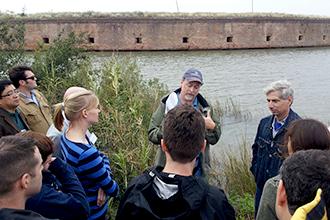Scientists pull together on global problem of coastal subsidence
“Sea-level rise will become our biggest enemy,” in terms of flooding in coastal areas, says Torbjörn Törnqvist, professor and chair of earth and environmental sciences at Tulane University.

Mead Allison, center, of Tulane and the Water Institute of the Gulf, leads a tour of greater New Orleans during a coastal subsidence workshop. The tour concentrated on the effects of subsidence, hurricanes and wetlands loss and ways to restore and protect the area. (Photo by Torbjörn Törnqvist)
But there is another factor at work in sinking coastlines that often does not get as much attention as rising seas. And that is coastal subsidence.
Scientists at the International Workshop on Coastal Subsidence held in New Orleans in November addressed the issue of the rapid rate of subsidence, especially in “mega cities,” such as Jakarta, Indonesia.
The workshop was sponsored by the Water Institute of the Gulf in partnership with Tulane University and Deltares, an applied coastal science institute headquartered in The Netherlands. Mead Allison, a Tulane professor of earth and environmental sciences and director of physical processes and sediment systems for the Water Institute, was the lead organizer of the workshop.
Like New Orleans, many major cities were established in deltaic regions where powerful rivers dispersing sediment built up land over millions of years. Now these highly populated areas with extensive infrastructure are in peril because of the twin problems of sea-level rise and coastal subsidence.
“In several cases, subsidence rates are way higher than rates of sea-level rise,” says Törnqvist. “That makes the whole problem worse because sea-level rise in itself is a big problem.”
The goal of the workshop was to discuss causes of coastal subsidence, research into rates of subsidence (on which there is still much work to be done, says Törnqvist) and how coastal subsidence can be mitigated.
The 40 workshop attendees were top-level scientists representing a wide range of disciplines. For example, Törnqvist said that at a breakfast session he sat next to a botanist and a geophysicist.
But “they were having an interesting exchange about the Ganges-Brahmaputra Delta in Bangladesh,” says Törnqvist. “Both of these people have important things to contribute to the understanding of subsidence.”
After the scientific workshop, a short course open to policymakers and the general public was held on the Tulane uptown campus. The short course, Soft Soils Need Solid Governance, attracted 50 participants.
